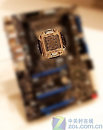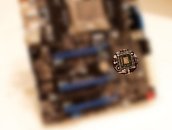Monday, January 10th 2011

Intel LGA2011 Socket, X68 Express Chipset Pictured
Here are the first pictures of Intel's new high-end CPU socket, the 2011-pin land grid array (LGA2011). A selection of pictures of an unannounced motherboard by MSI made it to the internet. LGA2011, coupled with a new chipset, the Intel X68 Express, will drive the company's new high-end and enthusiast-grade processors that feature 6, 8, or 12 cores, and quad-channel DDR3 memory controllers. At first sight, the LGA2011 is huge! Its retention clip looks to be completely detachable by unhooking the retention bars on either sides. With all LGA sockets till date, you needed to unhook one retention bar, letting you open the retention clip along a hinge.
Since the processor has four DDR3 memory channels, there's room for only one DIMM per channel on a typically-sized ATX motherboard. On this particular motherboard, we can make out that there are two DIMM slots on either sides of the socket, accommodating two channels each. With this platform, Intel transferred the northbridge component completely to the CPU package, much like LGA1156/LGA1155. Therefore, the 32-lane PCI-Express controller is housed inside the CPU package. What remains of the chipset is a PCH (platform controller hub). Like P55/H55/P67/H67, the X68 is a PCH, a glorified southbridge. It will house a smaller PCI-E hub that handles various connectivity devices, a storage controller, a LPCIO controller, USB and HDA controllers, and the DMI link to the processor. We will get to know more about this platform as the year progresses.
Source:
Zol.com.cn
Since the processor has four DDR3 memory channels, there's room for only one DIMM per channel on a typically-sized ATX motherboard. On this particular motherboard, we can make out that there are two DIMM slots on either sides of the socket, accommodating two channels each. With this platform, Intel transferred the northbridge component completely to the CPU package, much like LGA1156/LGA1155. Therefore, the 32-lane PCI-Express controller is housed inside the CPU package. What remains of the chipset is a PCH (platform controller hub). Like P55/H55/P67/H67, the X68 is a PCH, a glorified southbridge. It will house a smaller PCI-E hub that handles various connectivity devices, a storage controller, a LPCIO controller, USB and HDA controllers, and the DMI link to the processor. We will get to know more about this platform as the year progresses.



51 Comments on Intel LGA2011 Socket, X68 Express Chipset Pictured
if the 2600K is anything to go by... an 8 or 12 core will be rape on a stick.
A K or extreme edition LGA2011 12 core chip and board with 4 channels worth of 2ghz+ DDR3 i assume will not come cheap.
Although I'm unsure on the core count, i can't find much on it but on the sandy bridge wiki there is 6 and 8 core CPU's listed (although no reference thus why I'm still unsure) but with HT that would be 12 or 16 cores, either way there will be some insane benchmark world records set later this year with the right cooling.
we have 1155 instead of 1166 now 2011 and after 2 years 2013
where is greeen in these products they want us to dump the cool 1166 for 1155?? why is that just money money money
A 8-core or a 12-core will definitely completely trash everything from AMD, but then will cost 2-5 times more. Just like this generation... This platform is going to be cutting edge, but costs a load, so it'll be a perfect successor for LGA1366. TBH, a 8-core or a 12-core will be an overkill for the vast majority of users: the extra cores are really only useful in servers.
Though of course i can tell i won't be able to afford it, and my wallet starts crying just thinking about it how much the platform will be. lol
I am quite glad I skipped out on P55 and X58 mass adoption, as ram prices have come down so much quad channel makes sense, monetary wise anyway.
I'm glad I jumped onto LGA1366 early on. It was obvious they had a monster platform that would last for a variety of reasons (global economic slowdown, lack of competition in high-end, etc). This looks like what I will upgrade to come December 2011 or January 2012, if there are proper performance gains to be seen. None of this "many times faster in select applications" PR nonsense.
I mean, I would drop my i7/X58 setup in an instant for a single core rig running at say, 10GHz? Considering most apps (95%+???) are single threaded even today, a platform supporting a 10GHz CPU would pretty much burn and pillage through most benchmarks, apps, and games out there. Well, any game that is CPU dependent. Because, let's remember, multi-core CPU's come into existence only because of the "power wall". /sigh
But we don't even NEED triple channel memory. Overkill...... Tax return is coming soon..... Must resist....... ;)
Even when I am gaming I have 8-10 applications running not to mention a serious number of windows background services.
Try running an old P$, single core, run an app that uses 60% CPU power and then try opening something else.. you will see it chug for a while. That is gone thanks to multicore :) Not saying a 10GHz chip would not be nice though :)
Ya'all are thilly. Been out in the woods too long. There is one and only one reason to completely change a socket from an established standard. The message is coming in ... "make no mistake, this technology is in no way compatible with any other". Whatever Intel says the holes are, thats where the pins have to be. Mobo makers know why. They're the ones who have to disperse all that brain. Bet they would like to use a yellow:), cyan;), & magenta:mad: RCA male to male to plug into ...chassis mount, yadda yadda, but it is not what is needed.1156 was not needed. Pins had new jobs. Some were out of a job maybe (lots of these jobs were in ...:nutkick:). So you gotta redesign:roll: and make it incompatible anyway... you call the tune. :toast:
Things change. Once upon a time it was an article of faith in electronics engineering that if you needed to provide secondary cooling to components something was seriously wrong with your design:banghead:.
OMG forgot somthing verry important: 20 nm litografy tehnique on the CPU. This combination should eliminate any geometric problem with high freqency's ... i thing ...
Intel CPU+GPU+RAM module!
4-core 4GB 2-channel, or 8GB unlocked
6-core 6GB 3-channel, or 12GB unlocked
4+4-core 8GB 2+2 channel. or 16GB bigger modules unlocked
8+8-core 48GB 3+3 channel Ivy Bridge on 3011 socket (96GB big modules)
or if they could do away with seperate modules and have everything on cpu. its a hell of an idea